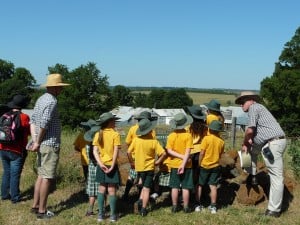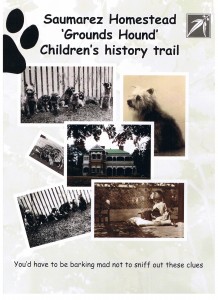The Saumarez Homestead “Grounds Hound” Children’s history trail provides an integral part of any Stage 1 school excursion to Saumarez concentrating on the Past in the Present (History K-10 Stage 1 HT 1-2, 1-3 and 1-4). The Grounds Hound history trail keeps the children focussed as the move around the grounds and helps maintain their concentration on what they are experiencing.
Saumarez Homestead Education Program Pre-visit Kit
These notes will help Teachers prepare for the experiences that the Saumarez Homestead Education Guides will lead.
SAUMAREZ PRIMARY SCHOOL GROUPS
TOUR IN FARM AREA – JUNIOR PRIMARY
Stage 2 Years 3 and 4 First Contact and Community and Rememberance
Syllabus links:
HT2-2 Describes and explains how significant individuals, groups and events contributed to changes in the local community over time
HT2-4 Describes and explains effects of British colonisation in Australia
HT2-5 applies skills of historical inquiry and communication
Booking arrangements: Time available for school tour?
House and /garden/ and farm tour?
House (downstairs only?) and farm?
Farm only? (all buildings & games)
Other alternatives?
The teacher in charge should decide whether the AV (12 minutes) is too long or too detailed for this age group.
The class may need to be divided into two or three groups when making the booking, and decide whether the AV should be seen before or after the tour?
Guide Notes: (For information of teachers accompanying students. Teachers will be asked what educational objectives they would like to be included in the visit to Saumarez Homestead and the program delivered can be adapted to satisfy these requests.
ROUTE:
Lead the group from the Saumarez Centre to the Farm area
either 1) pausing at the brow of the hill (old site of FJ White’s Office)
or 2) lead the group to the far end of the Trust property near the Thomas House
Question & Answer Session:
Landscape – Has it changed since Europeans arrived more than 170 years ago?
Who was living there? Did the landscape look the same?
What would the Aboriginal people eat? where would they live?
Why did British people settle there?
What did they need to live so far from Sydney?
What did they bring? why? how?
- Look at the buildings and the photograph on the stand below the Thomas House.
Compare the picture with the existing buildings –
Compare the buildings now and in the past- the materials used; walls, roofs, etc
- Explain the changes since European settlement
Water, power (horses), machines (less manpower needed) etc
Buildings erected, then demolished (replaced, change of use, modernized)
JUNIOR PRIMARY: Years 1 and 2 Past in the Present -Present and Past Family Life
Syllabus links:
HT1-1 communicates an understanding of change and continuity in family life using appropriate historical terms
HT1-2 identifies and describes significant people, events, places and sites in the local community over time
HT1-3 describes the effects of changing technology on people’s lives over time
HT1-4 demonstrates skills of historical inquiry and communication
HOMESTEAD & FARM
HOUSE (Downstairs only – if asked about what is upstairs answer “more bedrooms”.)
The house tour should be led with questions from the guide, and children answering the questions.
The question and answer system keeps the attention and interest of primary school children.
They can be asked the use of each room, to look for a mystery object such as the bell, usually near the fireplace; or gas bracket; use of certain objects such as coal scuttle, pole screen, bellows, bed warmer, samovar, chamber pot, brass hot water jug etc
e.g. In each room ask what was its use? bedroom, sitting room, dining room etc?
In each room ask the group to look for
1) Ask them to find the bells and count how many are in the house?
Ask who would use them and who would respond?
2) Mystery Objects
- Drawing room Music Box Gramophone
- Small sitting room Gas bracket Pole screen
- Office Sheep bell Pipe
- Frank’s bedroom Coal scuttle Chamber Pot
- Box Room Maggie’s wire dress dummy
- Elsie’s sitting room Bed Warmer Bellows
- Dining Room Dinner Bell Samovar
- Pantry Tray mobile Feather duster
- Kitchen Ice box Tins under meat safe legs
- Scullery Soap saver Mincer
- Laundry Copper & dollystick, Wringer & mangle
GARDEN
The different sections of the garden and the individuals involved with particular areas should be mentioned. The use of certain areas can be asked or suggested, like the former tennis court site, Mary’s garden, vegetable garden, picking garden, glass house, bird cage and sundial. Certain special trees may be pointed out, such as the ginkgo, camellia, and camphor laurel; deciduous trees and evergreens, or various different pines, and are there any Australian species?
– or the students may like to have time to explore the garden themselves.
FARM AREA
The class may look at the farm buildings from the brow of the hill before entering the Milking Shed. The use of the bails with their individual feed bins may be discussed and who did the milking; also use of the mystery objects [centrifuge] and slicing wheel [for pumpkins fed to cows while they are being milked by hand]
Lead the class down the hill through the yards to the farthest buildings [original homestead site]
Gather the class facing the photo on its stand near the Thomas House, and ask them if picture is the same as their view of the present day buildings [The original slab building has been demolished]
If they want to discover exactly where it stood Archaeologists would need to investigate the site.
Enter the THOMAS HOUSE [remnant of the original Homestead]
VARIATION OF TOUR – ARCHAEOLOGY GAME (for Junior Primary)
Having discussed the original homestead site and structure, enter the Thomas House for an Archaeological game. Its use as additional bedroom space for the original house should be explained, and the fact that the first homestead was demolished, but its brick addition retained. Show the diagrams on the wall where the first house stood, so that the group can learn more about the site and its use from objects discovered when former students excavated part of the site.
- 1. In the centre room show them the case full of curious objects found in the farm area (in the small case on the table). Ask the possible uses of the objects, and the reason for the variation in size of horseshoes; use of certain tools; pieces of broken china etc.
- Divide into three groups, and in each room, by checking the contents of each box (used as a rubbish bin) the group should decide whether it was the bedroom of a child (boy, girl or both) or an adult (man or woman)
- 3. When the Thomas House task is finished tell the group that they will now have the opportunity to dig part of the site to see if they can find objects buried when the house was demolished. Lead them out (last person closing the door) and walk past the dunny of the Jack Haynes Cottage to the area previously prepared into a square with subdivisions. There will be broken pieces of china, horse shoes, handmade nails, etc hidden beneath the soil. The students may take it in turns to dig, and then should tell the guide what the object is, and suggest its use.
On the walk back to the Saumarez Centre any route may be taken, but if time permits other buildings that may be visited and their use suggested, include the store building, the stables and poultry yard, the site of the piggery, the boiling down vats and the slaughterhouse. The family horse stables and horse stalls can be seen; also the carriage area, the staff mail pigeonholes, horse trough, harness room and feed bins, again asking the class the different uses of these spaces.
Other buildings to be seen, according to available time, are the Wagon shed and Blacksmith’s forge; the draught horse stable building with its different sections and their uses; and the Jackson Centre, formerly used for stables and a workshop
Time should be left to walk back up the hill to the Saumarez Centre for the prearranged break. The guide should move briskly both down to the lower part of the Farm site, and back to the Saumarez Centre for the break, keeping the group together and under control.
[The Archaeology section can be omitted if the school wants to visit all the farm buildings and have their use explained, as will happen with secondary school groups. Junior students will also follow the “Grounds Hound” Children’s History Trail, and fill in the blank boxes on the form]
AFTER THE BREAK
hose groups who have seen the House will do the Farm Tour
(including the Archaeology games if requested).
Those groups who began with the Farm Tour will do the House Tour.
Additional task for STUDENTS – House, Garden & Farm
“Grounds Hound” Children’s History Trail
This activity helps keep students focussed as they move about the Gardens, around the House and in the Farm Area
Each student will be given a copy of the questions and gaps for answers to be written
ANSWERS
A. ESSEX H. OTHERS
B.CAROLINE I. WHITE
C. 7 J. FROG
D. BELLOWS K. 1
E. 15 L. ALLEN OXFORD
F. 24 M. DASPYL
G. SQUARE N. NATIONAL TRUST
[BACK PAGE] ELSIE WHITE


